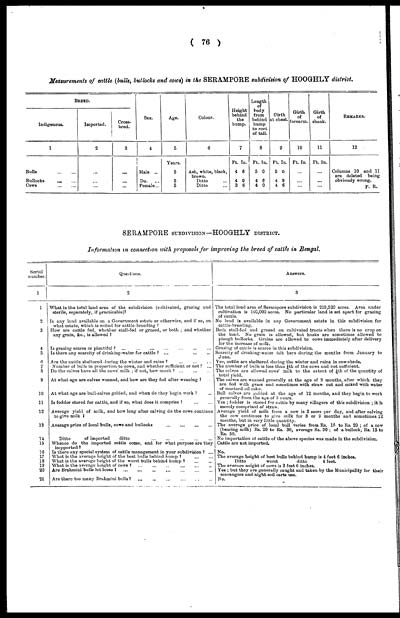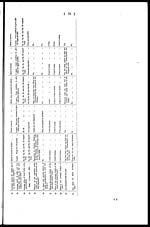Medicine - Veterinary > Civil Veterinary Departments > 1895-1951 - Annual report of the Civil Veterinary Department, Bengal > 1897-1898 - Annual report of the Civil Veterinary Department, Bengal, for the year 1897-98 > Annual report of the Civil Veterinary Department, Bengal, for the year 1897-98
(122) Page 76
Download files
Individual page:
Thumbnail gallery: Grid view | List view

( 76 )
Measurements of cattle (bulls, bullocks and cows) in the SERAMPORE subdivision of HOOGHLY district.
|
BREED. |
Sex. |
Age. |
Colour. |
Height |
Length |
Girth |
Girth |
Girth |
REMARKS. |
|||||
|
Indigenous. |
Imported. |
Cross- |
||||||||||||
|
1 |
2 |
3 |
4 |
5 |
6 |
7 |
8 |
9 |
10 |
11 |
12 |
|||
|
Years. |
Ft. |
In. |
Ft. |
In. |
Ft. |
In. |
Ft. In |
Ft. In. |
||||||
|
Bulls ... ... |
... |
... |
Male ... |
5 |
Ash, white, black, |
4 |
6 |
5 |
0 |
5 |
0 |
... |
... |
Columns 10 and 11 |
|
Bullocks ... ... |
... |
... |
Do. ... |
5 |
Ditto ... |
4 |
0 |
4 |
6 |
4 |
9 |
... |
... |
obviously wrong. |
|
Cows ... ... |
... |
... |
Female... |
5 |
Ditto ... |
3 |
6 |
4 |
0 |
4 |
6 |
... |
... |
F. R. |
SERAMPORE SUBDIVISION—HOOGHLY DISTRICT.
Information in connection with proposals for improving the breed of cattle in Bengal.
|
Serial |
Queations. |
Answers. |
|
1 |
3 |
|
|
What is the total land area of the subdivision (cultivated, grazing and |
The total land area of Serampore subdivision is 219,520 acres. Area under |
|
|
2 |
Is any land available on a Government estate or otherwise, and if so, on |
No land is available in any Government estate in this subdivision for |
|
3 |
How are cattle fed, whether stall-fed or grazed, or both ; and whether |
Both stall-fed and grazed on cultivated tracts when there is no crop on |
|
4 |
Is grazing scarce or plentiful ? ... ... ... ... ... ... ... |
Grazing of cattle is scarce in this subdivision. |
|
5 |
Is there any scarcity of drinking-water for cattle ? ... ... ... |
Scarcity of drinking-water left here during the months from January to |
|
6 |
Are the cattle sheltered during the winter and rains ? ... ... ... |
Yes, cattle are sheltered during the winter and rains in cow-sheds. |
|
7 |
Number of bulls in proportion to cows, and whether sufficient or not ? ... |
The number of bulls is less than ¼|th of the cows and not sufficient. |
|
3 |
Do the calves have all the cows' milk ; if not, how much ... ... ... |
The calves are allowed cows' milk to the extent of ¼th of the quantity of |
|
9 |
At what ago are calves weanod, and how are they fed after weaning ? ... |
The calves are weaned generally at the ago of 9 months, after which they |
|
10 |
At what ago are bull-calves gelded, and when do they begin work ? ... |
Bull calves are gehied at the age of 12 months, and they begin to work |
|
11 |
Is foddor stored for cattle, and if so, what does it comprise ? ... ... |
Yes ; fodder is stored for cattle by many villagers of this subdivision ; it is |
|
12 |
Average yield of milk, and how long after calving do the cows continue |
Average yield of milk from a cow is 3 seers per day, and after calving |
|
13 |
Average price of local bulls, cows and bullocks ... ... ... ... |
The average price of local bull varies from Rs. 15 to Rs. 20 ; of a cow |
|
14 |
Ditto of imported ditto ... ... ... ... ... |
No importation of cattle of the above species was made in the subdivision. |
|
15 |
Whenco do the imported cattle come, and for what purpose are they |
Cattle are not imported. |
|
16 |
Is there any special System of cattle management in your subdivision ? ... |
No. |
|
17 |
What is the average height of the best bulls behind hump ? ... ... |
The average height of best bulls behind hump is 4 foot 6 inches. |
|
18 |
What is the average height of the worst bulls behind hump ? ... ... |
Ditto worst ditto 4 feet. |
|
19 |
What is the average height of cows ? ... ... ... ... ... ... |
The average height of cows is 3 feet 6 inches. |
|
20 |
Are Brahmini bulls lot loose ? ... ... ... ... ... ... ... |
Yes ; but they are generally caught and taken by the Municipality for their |
|
21 |
Are there too many Brahmini bulls ? ... ... ... ... ... ... |
No. |
Set display mode to: Large image | Zoom image | Transcription
Images and transcriptions on this page, including medium image downloads, may be used under the Creative Commons Attribution 4.0 International Licence unless otherwise stated. ![]()
| Permanent URL | https://digital.nls.uk/76341774 |
|---|




